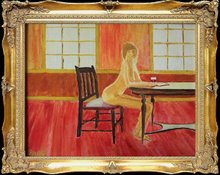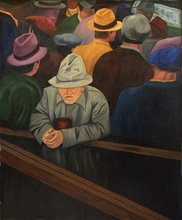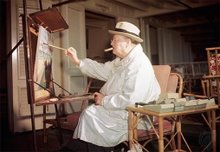
Friday, January 21, 2011
The Wait

Monday, January 3, 2011
Crazy Horse

Crazy Horse
11 x 14 inches
Oil on canvas
(c) Bill Brauker
About the Painting:
Why does this painting not look much like an Indian? The answer is simple, because Crazy Horse did not look much like an Indian.
Crazy Horse was most often described as small and slender, 5'6 to 5'8" very light complected, with long, fine, light brown hair and hazel eyes. When he was a child he was known by two names, given to him by his mother, Curley and Light Hair, because of his unusual hair.
In an interview at Pine Ridge, South Dakota, July 8, 1930, (Mrs. Annie Rowland, interpreter) Red Feather, Crazy Horse's brother in law said, "Crazy Horse was a nice-looking man, with brown, not black, hair, a sharp nose, and a narrow face. Nobody on the reservation nowadays looks like him. His nose was straight and thin. His hair was very long, straight, and fine in texture. "
In 1867, Crazy Horse was shot in the face with a small pistol wielded by a jealous husband. The bullet entered his face close to the left nostril and exited out his neck just under the back of his skull. The recovery was slow but complete, and a scar remained the rest of his life.
Short Bull, (aka Short Buffalo) a Sioux warrior who fought with Crazy Horse at the Little Bighorn, said, “Crazy Horse was a man not very tall and not very short, neither broad nor thin. His hair was very light about the color of yours. (The interviewer could be described as a medium blonde).
“But Crazy Horse had a very light complexion, much lighter than the other Indians. He usually wore a Iroquois shell necklace; this was the only ornament he wore. His features were not like those of the rest of us. His face was not broad, and he had a sharp, high nose. He had black eyes that hardly ever looked straight at a man, but they didn't miss much that was going on, all the same. " (The Nebraska Indian Wars Reader edited by R. Eli Paul, University of Nebraska Press, Lincoln, NE 1998, p 202 - 208 )
Frank Grouard was a scout and interpreter for the cavalry. In his younger years, he had lived in the camps of Sitting Bull and Crazy Horse for seven to eight years. He said, "Crazy Horse had somewhat peculiar features. He had sandy hair and was of a very light complexion. He didn't have the high cheekbones that the Indians generally have and didn't talk much. He was a young looking Indian -- appeared much younger than his age. There were a few powder marks on one side of his face.
Little Killer, a long time friend of Crazy Horse, was interviewed by Eleanor Hinman on July 12, 1930. (Translated by Samuel Stands.) When asked to describe him, Little Killer said, "Crazy Horse was a short, little man. He did not have black hair; he had brown hair like a white man's and a long straight nose. His eyes were black like a Lakota's."
Susan Bordeaux Bettelyoun was born in 1857 to a fur trader and, a Brule Lakota woman. She lived at Fort Robinson where Crazy Horse surrendered to authorities in 1877. In later life, she described an encounter with him. "My husband, Chas. Tackett, was a scout, but when he was not on duty, he clerked in Jewett's store, and [he] had waited on Crazy Horse. My mother-in-law and I drove up to the store one day when Crazy Horse was there; she pointed him out to me. He was a very handsome young man of about thirty-six years or so. He was not so dark; he had hazel eyes, [and] nice, long light-brown hair.
What did Crazy Horse really look like? We may never know. Although there are some photographs that have been touted as being the Sioux warrior, none have been authenticated.
About Custer and Crazy Horse:
I have had an interest in history all my life, and last fall, made a road trip up into Wyoming, Montana, and South Dakota, visiting the Little Bighorn Battlefield, Deadwood, and Ft. Laramine. Since my return, I have been devouring books about the battle of the Little Bighorn, and all the fascinating characters who came together at that time. It was a true clash of cultures and I find myself understanding and sympathizing with both sides. These were men who were doing what they thought was right.
The two main players, George Armstrong Custer and Crazy Horse have much in common They were almost the same age, they were courageous fighters, and both were charismatic leaders.
Custer was a true hero of the Civil War. He won a major battle at Gettysburg that turned the tide for the Union Army. He also played a major role at the end of the war when he led the troops that trapped Robert E. Lee at the Appomattox Court House. Lee met General Ulysses Grant at Appomattox and surrendered the Army of Northern Virginia on April 9.
General Phillip Sheridan was so impressed by Custer's service, that he bought the table on which Grant had written the terms of surrender. He presented the table to Custer's wife Libbie and wrote her that, "I respectfully present to you the small writing table on which the conditions for surrender of the Confederate Army of Northern Virginia was written by Lt. General Grant — and permit me to say Madam, that there was scarcely an individual in our service who has contributed more to bring about this desirable result than your very gallant husband." (The table is now in the Smithsonian Institution.
Through the late 1850s and early 1860s, Crazy Horse's reputation as a warrior grew, He was at every major battle of the Plains wars, and was always a leader. He was a major force at the Battle of the Little Bighorn that destroyed Custer and his entire force. There was no other Sioux warrior as famous in battle as the quiet, slender, Crazy Horse, who led not through words, but by actions.
After Crazy Horse turned himself in to authorities and vowed never to fight again, the attention paid to him by the Army caused friction with other chiefs. Soon rumors were spread that Crazy Horse was going to kill a general and go back on the war path. There was much trouble brewing. On September 5, 1877, he was led from his encampment to Fort Robinson, for what he thought was a meeting with army authorities. When he entered the fort, he was led toward a building by an army guard on one arm and by his life long friend, Little Big Man, holding his other arm. (Yes, there really was a Little Big Man. Unfortunately in the end, he betrayed his friend Crazy Horse.) As they neared it, Crazy Horse realized it was the guardhouse and that he was to be imprisoned. He began to struggle to break free and a guard stabbed him in the back with a bayonet.
A few hours later, Crazy horse was dead, a little over a year after his greatest triumph at the battle of the Little Bighorn.






